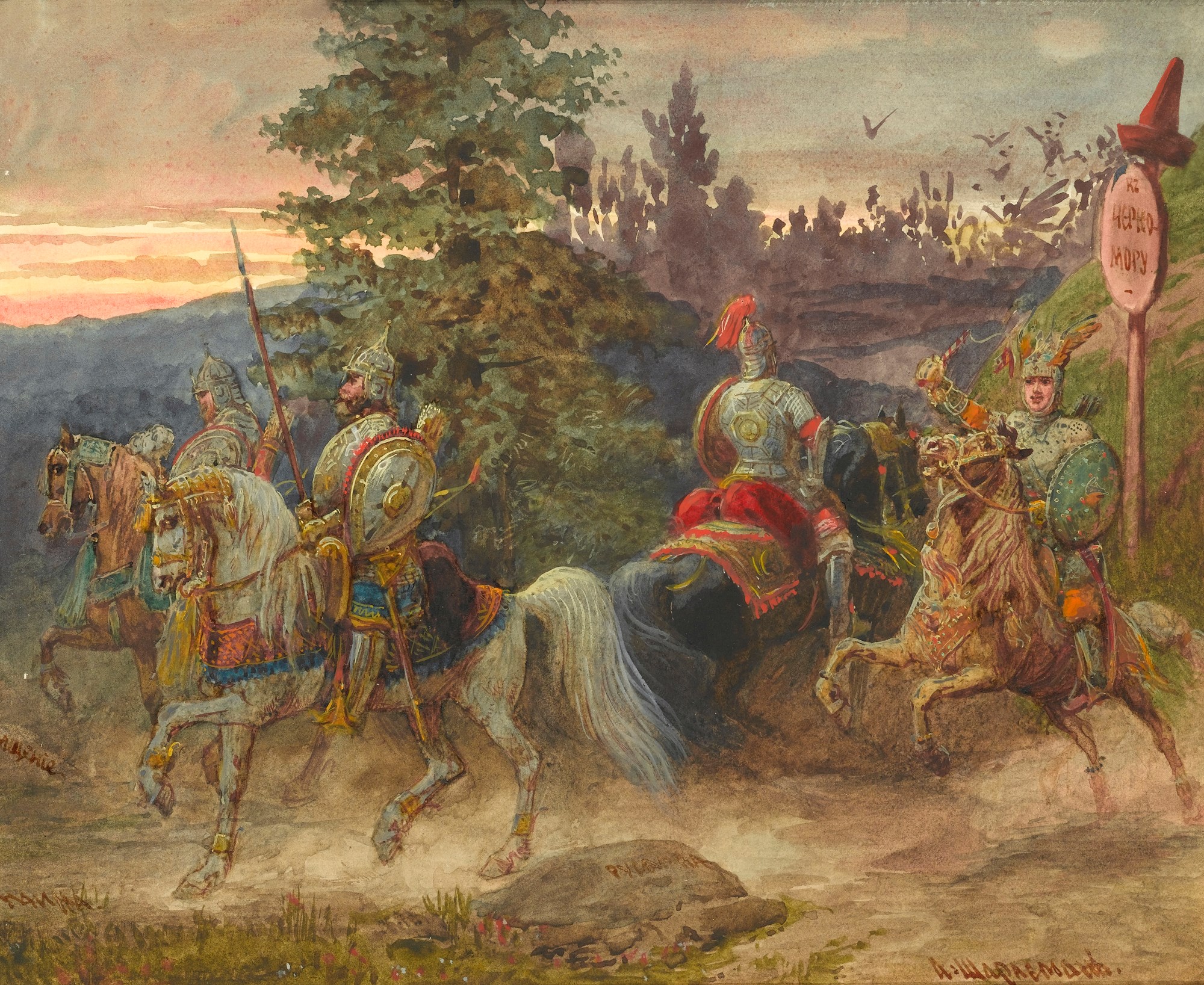Marketplace
The Road to Chernomor
Adolphe Josefovich Charlemagne
The Road to Chernomor
Epoque 1850-1900, 19th century
Origine Russia
Medium Watercolour, Gouache on paper
Dimension 17 x 21 cm (6³/₄ x 8¹/₄ inches)
This dramatic work is based on one of Alexander Pushkin’s (1799-1837) better known fairy-tales, Ruslan and Ludmilla. Pushkin began writing the poem in 1817 while attending the Imperial Lyceum at Tsarskoe Selo. He based it on folk tales that he had heard as a child, and the first edition of the story was published in 1820. The story was also made into an opera by the Russian composer, Mikhail Glinka (1804-1857).
Four knights, including the hero Ruslan, set out to find Princess Ludmilla who has been kidnapped by the wicked sorcerer Chernomor. In The Road to Chernomor, the sorcerer’s hat can be seen balanced atop a signpost directing the hopeful knights towards his lair where the unfortunate Ludmilla has been incarcerated. Ruslan is decked out in a splendid suit of armour and distinguished from the others by his flamboyant turquoise-plumed helmet. The names of the heroes are even written faintly in Cyrillic beneath their portraits.
Adolphe Josefovich Charlemagne’s faithful representation of the four horses derives from his patient study of the animals in a number of his other works, particularly in the battle scenes for which he is most renowned. While not a great deal is known about Charlemagne’s life, his importance as an artist can be deduced from the number of imperial commissions that he received. A number of compositions record events such as the funeral procession of Alexander II (1818-1881) and recreations of scenes at the court of the Empress Catherine II (1729-1796).
Charlemagne entered the Academy in 1848 where he studied historic painting under Feodor Antonovich Bruni (1799-1875) and battle painting with Bogdan Pavlovich Villevalde. He spent the majority of his career working on official commissions which recorded the major events in the reign of Alexander II, and in 1875 he was awarded the title of Artist of His Imperial Majesty.
This work comes from a unique album of drawings, watercolours, musical quotations and letters, collected by the son of Eduard Frantsevich Napravnik (1839-1916), Vladimir. As chief conductor of the Mariinsky Theatre from the 1868 until his death in 1916, Eduard Napravnik occupied one of the most important roles in Russian musical life. He led the world premieres of many of the late nineteenth-century operas which today constitute the nucleus of the classical Russian repertory including Nikolia Rimsky-Korsakov’s (1844-1908) The Night before Christmas and Pyotr Tchaikovsky’s (1840-1893) Queen of Spades. Fyodor Dostoyevsky (1821-1888) even mentions the great conductor in his book, The Brothers Karamazov: ‘Mr. Napravnik is our well-known Russian orchestra conductor’.¹ The conductor also delivered the second public performance of Tchaikovsky’s celebrated Pathétique Symphony (no. 6) a week after the composer’s death, restoring the music to its rightful place after a disastrous premiere.
¹ Dostoyevsky, F., The Brothers Karamazov (Penguin Books, London, 1880), Book 2, Chapter 2.
Four knights, including the hero Ruslan, set out to find Princess Ludmilla who has been kidnapped by the wicked sorcerer Chernomor. In The Road to Chernomor, the sorcerer’s hat can be seen balanced atop a signpost directing the hopeful knights towards his lair where the unfortunate Ludmilla has been incarcerated. Ruslan is decked out in a splendid suit of armour and distinguished from the others by his flamboyant turquoise-plumed helmet. The names of the heroes are even written faintly in Cyrillic beneath their portraits.
Adolphe Josefovich Charlemagne’s faithful representation of the four horses derives from his patient study of the animals in a number of his other works, particularly in the battle scenes for which he is most renowned. While not a great deal is known about Charlemagne’s life, his importance as an artist can be deduced from the number of imperial commissions that he received. A number of compositions record events such as the funeral procession of Alexander II (1818-1881) and recreations of scenes at the court of the Empress Catherine II (1729-1796).
Charlemagne entered the Academy in 1848 where he studied historic painting under Feodor Antonovich Bruni (1799-1875) and battle painting with Bogdan Pavlovich Villevalde. He spent the majority of his career working on official commissions which recorded the major events in the reign of Alexander II, and in 1875 he was awarded the title of Artist of His Imperial Majesty.
This work comes from a unique album of drawings, watercolours, musical quotations and letters, collected by the son of Eduard Frantsevich Napravnik (1839-1916), Vladimir. As chief conductor of the Mariinsky Theatre from the 1868 until his death in 1916, Eduard Napravnik occupied one of the most important roles in Russian musical life. He led the world premieres of many of the late nineteenth-century operas which today constitute the nucleus of the classical Russian repertory including Nikolia Rimsky-Korsakov’s (1844-1908) The Night before Christmas and Pyotr Tchaikovsky’s (1840-1893) Queen of Spades. Fyodor Dostoyevsky (1821-1888) even mentions the great conductor in his book, The Brothers Karamazov: ‘Mr. Napravnik is our well-known Russian orchestra conductor’.¹ The conductor also delivered the second public performance of Tchaikovsky’s celebrated Pathétique Symphony (no. 6) a week after the composer’s death, restoring the music to its rightful place after a disastrous premiere.
¹ Dostoyevsky, F., The Brothers Karamazov (Penguin Books, London, 1880), Book 2, Chapter 2.
Epoque: 1850-1900, 19th century
Origine: Russia
Medium: Watercolour, Gouache on paper
Signature: Signed in Cyrillic (lower right), variously inscribed in Cyrillic (near each figure).
Dimension: 17 x 21 cm (6³/₄ x 8¹/₄ inches)
Provenance: A gift from the artist to Vladimir Eduardovich Napravnik (1869—1948);
Thence by descent
Plus d'œuvres d'art de la Galerie







 A Woman Bending forwards in Work, and_T638856835938571470.jpg?width=500&height=500&mode=pad&scale=both&qlt=90&format=jpg)

